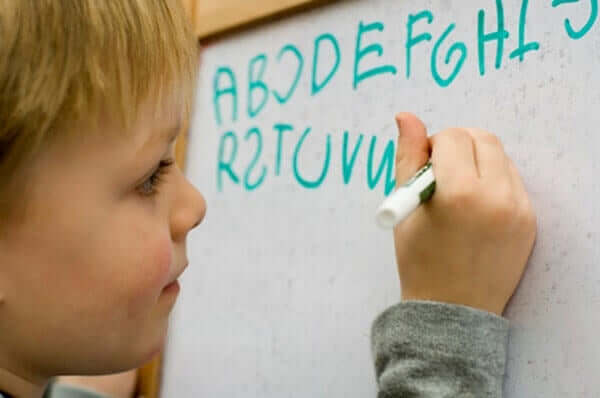What Are Simple Language Delays?


Reviewed and approved by the psychologist María Alejandra Castro Arbeláez
Simple language delays are a language disorder characterized by low use of words during childhood. In other words, a minor who has simple language delays doesn’t use most of the words that the other children in their age group use to communicate. They have a certain delay in using phonemes and combining words (syntax) to express an idea.
Children learn to speak because they imitate other human beings, especially their attachment figure and the other people with whom they live. That’s why it’s said that the home is a child’s first school.
Those who live in a quiet environment in which family members speak very little to each other and prefer, for example, social networks to communicate with friends and family, could develop this dysfunction.
But a child who lives in an active environment where everyone talks and talks non-stop may also find it difficult to express themself, because, although the home is stimulating, each human being already comes with the vestiges of what their personality will be in adult life.
Now, you should know that this disorder isn’t a problem that can’t be corrected. In fact, it’s one of the easiest to remedy, especially if action is taken from an early age.

Keep in mind that language will help the child to communicate with their peers and establish better social relationships. It will allow them to express their points of view and will be a powerful tool for them to be able to develop in their school environment and achieve cognitive and thinking maturity.
This time lag with respect to speech, although it’s not an impediment to the child’s learning and mental development, does hinder it. So, if you notice that your little one is quiet and when they speak they don’t articulate correctly, if they express themself rather through sounds, pointing, and they have trouble using the words that other children use, we recommend that you stimulate their language with these simple but fun activities.
How to improve simple language delays
Sing
Nursery rhymes are excellent for teaching a child to speak, introducing them to new words, and making them understand what each thing is called and how it’s pronounced. If at home everyone says “vroom vroom”, when they mean “car”, songs can help children to learn the correct words and to pronounce them correctly.
So, use nursery rhymes for them to learn. Listen to them, dance together, and sing them. While having fun, make sure that your child repeats the end of the sentences correctly (because most of the time, it’s the end of the syllables which they’ll learn).
Translate sounds
Make a game of translating sounds. Imitate, for example, a cat’s meow and ask them what little animal does this. They may answer you: “at”, and then you will have to correct them: “Cat”. And you’ll ask them to repeat the word.
Converse while you play

Say small sentences or very simple phrases while you play. Through dialogue, introduce different words so that your child learns to say them correctly.
If you ask them, “can I borrow this car?”, they may answer you by nodding with their head. You should tell them to answer you by saying something like: “Yes, mom, take the car”. Ask them to repeat this for you.
Tips for mothers of children with simple language delays
Mom and dad, before finishing the article, we must talk to you about two issues that will help your child to express themself better and overcome this difficulty.
- Don’t let them point fingers or make sounds to indicate that they want something. Pretend you don’t understand them and ask them to speak to you to find out what they want or what they want to say to you. If, for example, they want water, don’t run to give it to them just because he brought you the cup that they usually drink from. Encourage them to tell you that they want water and wait for them to speak to you
- Correct them. We’re not suggesting that you spend the entire day policing their speech and correcting all the phonemes. But, at all times, and especially with the words they use the most, make them repeat the correct pronunciations.
Simple language delays are a language disorder characterized by low use of words during childhood. In other words, a minor who has simple language delays doesn’t use most of the words that the other children in their age group use to communicate. They have a certain delay in using phonemes and combining words (syntax) to express an idea.
Children learn to speak because they imitate other human beings, especially their attachment figure and the other people with whom they live. That’s why it’s said that the home is a child’s first school.
Those who live in a quiet environment in which family members speak very little to each other and prefer, for example, social networks to communicate with friends and family, could develop this dysfunction.
But a child who lives in an active environment where everyone talks and talks non-stop may also find it difficult to express themself, because, although the home is stimulating, each human being already comes with the vestiges of what their personality will be in adult life.
Now, you should know that this disorder isn’t a problem that can’t be corrected. In fact, it’s one of the easiest to remedy, especially if action is taken from an early age.

Keep in mind that language will help the child to communicate with their peers and establish better social relationships. It will allow them to express their points of view and will be a powerful tool for them to be able to develop in their school environment and achieve cognitive and thinking maturity.
This time lag with respect to speech, although it’s not an impediment to the child’s learning and mental development, does hinder it. So, if you notice that your little one is quiet and when they speak they don’t articulate correctly, if they express themself rather through sounds, pointing, and they have trouble using the words that other children use, we recommend that you stimulate their language with these simple but fun activities.
How to improve simple language delays
Sing
Nursery rhymes are excellent for teaching a child to speak, introducing them to new words, and making them understand what each thing is called and how it’s pronounced. If at home everyone says “vroom vroom”, when they mean “car”, songs can help children to learn the correct words and to pronounce them correctly.
So, use nursery rhymes for them to learn. Listen to them, dance together, and sing them. While having fun, make sure that your child repeats the end of the sentences correctly (because most of the time, it’s the end of the syllables which they’ll learn).
Translate sounds
Make a game of translating sounds. Imitate, for example, a cat’s meow and ask them what little animal does this. They may answer you: “at”, and then you will have to correct them: “Cat”. And you’ll ask them to repeat the word.
Converse while you play

Say small sentences or very simple phrases while you play. Through dialogue, introduce different words so that your child learns to say them correctly.
If you ask them, “can I borrow this car?”, they may answer you by nodding with their head. You should tell them to answer you by saying something like: “Yes, mom, take the car”. Ask them to repeat this for you.
Tips for mothers of children with simple language delays
Mom and dad, before finishing the article, we must talk to you about two issues that will help your child to express themself better and overcome this difficulty.
- Don’t let them point fingers or make sounds to indicate that they want something. Pretend you don’t understand them and ask them to speak to you to find out what they want or what they want to say to you. If, for example, they want water, don’t run to give it to them just because he brought you the cup that they usually drink from. Encourage them to tell you that they want water and wait for them to speak to you
- Correct them. We’re not suggesting that you spend the entire day policing their speech and correcting all the phonemes. But, at all times, and especially with the words they use the most, make them repeat the correct pronunciations.
All cited sources were thoroughly reviewed by our team to ensure their quality, reliability, currency, and validity. The bibliography of this article was considered reliable and of academic or scientific accuracy.
- Artigas, J., Rigau, E., & García-Nonell, K. (2008). Trastornos del lenguaje. AEP: Protocolos de actualización, 24, 178-84. http://www.aeped.es/sites/default/files/documentos/24-lenguaje.pdf
- i Cusidó, E. S. (1992). Retraso del lenguaje y adquisición de la morfología. Revista de Logopedia, Foniatría y Audiología, 12(1), 39-44. https://www.sciencedirect.com/science/article/pii/S0214460392755326
This text is provided for informational purposes only and does not replace consultation with a professional. If in doubt, consult your specialist.








